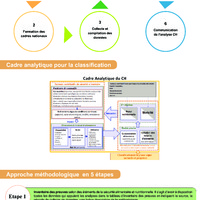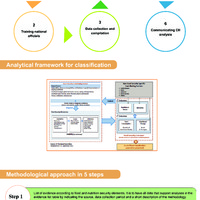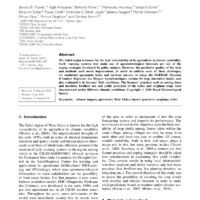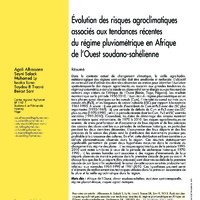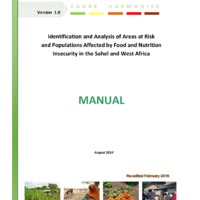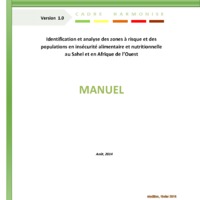Recherche
7 items
Bulletin special cadre harmonise
La situation alimentaire est globalement plus favorable en 2013. Mais, il existe beaucoup de stress et de zones localisées de crise (en phase actuelle ou à venir).
Characterizing and modeling the diversity of cropping situations under climatic constraints in west africa
The Sahel region is known for the high vulnerability of its agriculture to climate variability. Early warning systems that make use of agrometerological forecasts are one of the coping strategies developed by policy makers. However, the predictive quality of the tools and methods used needs improvement. In order to address some of these challenges, we conducted agronomic trials and on-farm surveys to adapt the SARRAH (Syst`eme d’Analyse R´egionale des Risques Agroclimatiques, version H) crop simulation model, and also evaluated it in farmers’ field conditions. The farmers’ practices such as sowing dates and densities, fertilizer use and yields potentials of the millet and sorghum crops were characterized under different climatic conditions.
Evolution des risques agroclimatiques associés aux tendances récentes du régime pluviométrique en afrique de l’ouest soudano-sahélienne
Dans le contexte actuel de changement climatique, la veille agro-hydrométéorologique des regions semi-arides doit être ameliorée et renforcée. L’objectif de ce travail est d’utiliser des données observées en station pour identifier l’evolution spatio-temporelle des risques agroclimatiques associés aux grandes tendances du régime pluviométrique dans la bande soudano-sahélienne élargie aux parties Nord de certains pays côtiers de l’Afrique de l’Ouest (Benin, Togo, Nigeria). Les resultats montrent que sur la periode 1950-2010, l’evolution du regime pluviometrique est en trois phases quasi identiques sur les cumuls (Cum), l’intensite du cumul sur trois jours consecutifs (Px3), et les longueurs de saison culturale (LSC) par rapport a la normale 1961-1990. A savoir : i) une periode d’excedents de Cum et Px3 avec des LSC plus importantes (1950-1969) ; ii) une periode de deficits de Cum et Px3 avec des LSC plus courtes (1970-1990) ; et iii) la période récente dont les Cum, Px3 et LSC sont trés variables (1991-2010). Cependant, les dates de demarrage des saisons montrent une tendance quasi stationnaire, de 1970 a 2010. Les risques agroclimatiques de resemis, de stress post-floraison et d’occurrence de faux departs et de fins precoces des saisons des pluies sont lies aux periodes de secheresse historique, en particulier pendant les deux dernieres decennies. L’occurrence des faux departs et des fins precoces de la saison des pluies rend la distribution des evenements pluvieux peu profitable à la croissance des cultures
Identification and Analysis of Areas at Risk and Populations Affected by Food and Nutrition Insecurity in the Sahel and West Africa
Facing recurrent food and nutrition insecurity affecting Sahelian and West African populations, governments and their development partners have set up mechanisms to monitor food situation. However, these mechanisms do not use the same methodological approaches, which often lead to results that are difficult to compare and which at times are even contradictory. Aware of this situation and the need to find a suitable solution, CILSS member states and partners have initiated the development of a Cadre harmonisé d’identification et d’analyse des zones à risque et des populations en insécurité alimentaire et nutritionnelle au Sahel et en Afrique de l’Ouest (Harmonized Framework for Identification and Analysis of Areas at Risk of and Populations Affected by Food and Nutrition Insecurity in the Sahel and West Africa). This tool, known as “Cadre Harmonisé” (CH), is expected to serve as a framework for countries to assess food and nutrition insecurity on an objective and consensual basis. The purpose of the Cadre Harmonisé is to help countries prevent food crises better and, where appropriate, quickly identify affected populations and appropriate measures to improve their food and nutrition security. The related method has been developed by a group of food and nutrition security experts from CILSS, FAO, WFP, FEWS NET, AFD, IPC/GSU, JRC/EC and UNICEF, and from international NGOs Oxfam International, Save the Children and ACF1. It is worth recalling that starting from 2008, various meetings held by the CH Technical Committee agreed for the CH to include some elements of the Integrated Food Security Phase classification version 1 (IPC 1.0). The IPC is a set of tools and procedures for classifying food and nutrition insecurity severity for decision making. Since the development of a manual for IPC 2.0, discussions have been under way to bring the CH closer to the IPC to incorporate lessons learned that improve comparability of results from the two tools. Similar to the IPC, the Cadre Harmonisé seeks to make best use of a set of tools and procedures for classifying the nature and severity of current and projected food and nutrition insecurity situations on the basis of a consensual analytical framework and classification scale. The CH is based on the following four conceptual models commonly used by national, regional and global mechanisms: Risk = f (Hazard, Vulnerability) Sustainable Livelihoods Framework The UNICEF Nutrition Conceptual Framework The four dimensions of food security (availability, access, utilization, and stability) The CH therefore is an integrated analytical framework built on a technical consensus that seeks to make best use of data from all systems or methods, namely food consumption surveys, nutrition surveys, the Household Economy Approach (HEA) or other information provided by agricultural surveys and market monitoring. The CH assesses food and nutrition insecurity, based on convergence of evidence from several indicators. The CH uses a food insecurity severity scale with five phases. Such a severity scale, which is an international one, makes it possible to make comparisons between countries of the sub-region and also at global level. CILSS was mandated to develop and implement the CH as a common tool for Sahelian and West African countries. Its analysis cycles will from now on help develop regional mapping of current food and nutrition situations and analyze projected situations. 1 Other institutions such as MIFRAC, IBIMET and CARE International initially contributed to the development of the present analytical framework. Cadre Harmonisé MANUAL Version 1.0 Page | 13 The CH also seeks to strengthen the regional integration framework in the CILSS-ECOWAS-UEMOA region so that collaborative and harmonized analyses of food and nutrition situations are conducted through the best possible use of other tools and analysis methods developed by national mechanisms and partners. Given the importance of the process of harmonizing the analytical framework for food and nutrition situations in West Africa, it is necessary that all food and nutrition security stakeholders take ownership of it and make it their decision-making tool. Furthermore, efforts are needed to strengthen the partnership framework within countries and to support the operations of early warning systems in order to improve the collection of reliable data. CH implementation relies on existing data collection mechanisms. Efforts should be made by countries and partners to provide financial support to these mechanisms - as CH implementation will from now on be the baseline reference for activating regional food reserves and mobilizing technical and financial partners (TFPs).
Identification et analyse des zones à risques et des populations en insécurité alimentaire et nutritionnelle au Sahel et en Afrique de l'Ouest
Face à l’insécurité alimentaire et nutritionnelle récurrente qui affecte les populations sahéliennes et ouest-africaines, les Etats et leurs partenaires au développement ont mis en place des dispositifs de suivi de la situation alimentaire. Malheureusement, ces dispositifs n’utilisaient pas les mêmes approches méthodologiques, ce qui a souvent conduit à des résultats difficilement comparables et parfois même contradictoires. Conscients de cette situation et de la nécessité de lui trouver une solution appropriée, le CILSS, les Etats membres et les partenaires ont initié le « Cadre Harmonisé d’identification et d’analyse des zones à risque et des populations en insécurité alimentaire et nutritionnelle au Sahel et en Afrique de l’Ouest».
